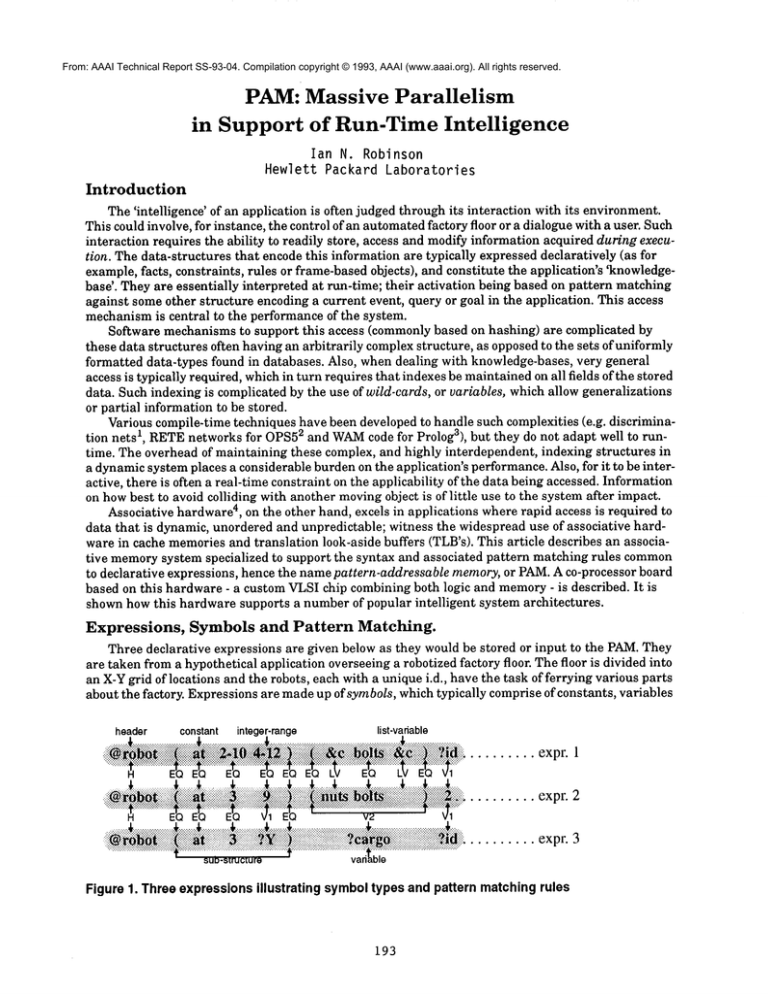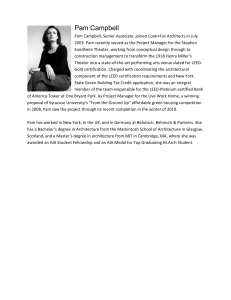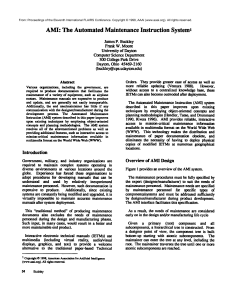
From: AAAI Technical Report SS-93-04. Compilation copyright © 1993, AAAI (www.aaai.org). All rights reserved.
PAM: Massive Parallelism
in Support of Run-Time Intelligence
Hewlett
lan N. Robinson
Packard Laboratories
Introduction
The ’intelligence’ of an application is often judged through its interaction with its environment.
This could involve, for instance, the control of an automatedfactory floor or a dialogue with a user. Such
interaction requires the ability to readily store, access and modifyinformation acquired during execution. The data-structures that encode this information are typically expressed declaratively (as for
example, facts, constraints, rules or frame-based objects), and constitute the application’s ’knowledgebase’. They are essentially interpreted at run-time; their activation being based on pattern matching
against someother structure encoding a current event, query or goal in the application. This access
mechanismis central to the performance of the system.
Software mechanismsto support this access (commonlybased on hashing) are complicated
these data structures often having an arbitrarily complexstructure, as opposedto the sets of uniformly
formatted data-types found in databases. Also, whendealing with knowledge-bases, very general
access is typically required, whichin turn requires that indexes be maintainedon all fields of the stored
data. Such indexing is complicated by the use of wild-cards, or variables, whichallow generalizations
or partial information to be stored.
Various compile-time techniques have been developed to handle such complexities (e.g. discrimination nets l, RETEnetworks for OPS52 and WAM
code for Prolog3), but they do not adapt well to runtime. The overhead of maintaining these complex, and highly interdependent, indexing structures in
a dynamicsystem places a considerable burden on the application’s performance.Also, for it to be interactive, there is often a real-time constraint on the applicability of the data being accessed. Information
on howbest to avoid colliding with another movingobject is of little use to the system after impact.
Associative hardware4, on the other hand, excels in applications where rapid access is required to
data that is dynamic, unordered and unpredictable; witness the widespread use of associative hardware in cache memoriesand translation look-aside buffers (TLB’s). This article describes an associative memorysystem specialized to support the syntax and associated pattern matching rules common
to declarative expressions, hence the namepattern-addressable memory,or PAM.A co-processor board
based on this hardware - a custom VLSIchip combiningboth logic and memory- is described. It is
shownhow this hardware supports a number of popular intelligent system architectures.
Expressions,
Symbols
and Pattern
Matching.
Three declarative expressions are given below as they would be stored or input to the PAM.They
are taken from a hypothetical application overseeing a robotized factory floor. The floor is divided into
an X-Ygrid of locations and the robots, each with a unique i.d., have the task of ferrying various parts
about the factory. Expressions are madeup of symbols, whichtypically comprise of constants, variables
header
constant integer-range
list-variable
, ~ @~
~; i ~ ~~~ ~i i i i ~~~ ~i~i~iii~iiiiii~i~i~i~i~i~iiiiiii~~iiiii~ii~iiii~iiii!~!~i~i
......... expr. 1
..................
.................
................................
~ i@~ii~ii~iiiii~i~iiiii~ii~i~iiiiii~i~!~!i~ii~ii~l~iii~iiii~i!iiiii~iii~i~i~i~i~i~iiiiii~
......... expr. 2
~............
:~
......................
~...................
~.......~..............................
~..................................................
~........
......~................
~~i~i~!~!~i~i!!~!ii!!~i
i!~i~!!~iii~iiiii~iiii~i~!!i~i~ii~i!iiii~iii~ii?~!~!iiiiii;~i~|~i~L
......... ¢xpr. 3
Figure1. Threeexpressions
illustrating symbol
typesand pattern matchingrules
193
PAM:Massive Parallelism in Support of Run-TimeIntelligence
and the parentheses delimiting sub-structure.
Headers are constants that indicate the start of a new
expression. The PAMhardware also supports integer ranges and inequalities (that also allow a kind of
fuzzy matching), and list-variables
which allow arbitrary numbers of list elements to be matched (as
in the cargo list of this example).
Thus expression 1 describes some robot within 4 squares of(6, 8) carrying, amongst possibly other
things, bolts. Expression 2 describes a robot at location (3, 9) carrying nuts and bolts, and with an i.d.
of 2. Expression 3 describes some robot on the x=3 axis.
The arrows between expressions illustrate
the pattern matching rules (H, EQ, V1, V2 and LV) that
lead to the three expressions pattern matching one-another. Headers only match headers with the
same name (H). Constants and parentheses match their equivalents (EQ). A variable matches
other variable or constant (V1) or sub-structure (V2). A list-variable
matches any number of constants,
variables and/or parentheses, including none (LV).
The PAMstores symbols as 32-bit words, the first four bits of which denote the type.
Pattern-Addressable
Memory
A number of associative memories designed to support matching on symbolic data exist 4’ 5, 6. Such
hardware has typically been based on traditional
content-addressable
memory, with any additional
logic being replicated for every word of storage. Pattern matching using the full syntax of declarative
expressions is not well suited to this organization as so much of the process cannot be supported by
comparators alone. Adding to the complexity of the additional logic, with the frequency of its replication, quickly gives rise to unworkably poor memorydensities.
’,
~iiiii:’
’iiiii~iiiiiil
’,iiii~iT’,’,~,’,
~’~’~"
::ii~}i~iiii
iiiii~8t:(~iiiill
iiii~::!~i::iiii
::::::::::i::::
::iii
iii::iiiiiiiiii
liiiii~iiii~ii
I:,’,’,’~
.............................................
liiii~O!~iiiiii
liiii/lil ~
data
::::::::::
::::::::::::::::::::
:::::
::::::::::::::::::
::::
::::::::::::::~ii::
li::i::i
i::i::i::iiiiiiiiiiiiiiiiiiiiiiiiiiiil
Ii;!i;iiii;iii;iiiiiil;iiiiiii
iiiiil;i;;I
:::::::::::::::::::::::::::::::::::::::::::::::::::::
::i:,i::i
ii::i
i;iiiiiiiilJ
L
!t
Tt t
o~-°od~!
t t T’~’1’
I ~ s tdata I ~ I ".~
t I °hip~"’b~P I "
I
111
1’
"-~,
-,
"..
hostsystem
bus
:~, op-code
~
.....
I
comparatorJ
Figure 2. PAMArchitecture
The PAMchip uses an organization in which the comparators and the match logic are multiplexed
over small blocks of conventional RAM.This match engine with its attached memory forms the basic
building block for the PAMchip (see Figure 2). The co-processor board, in turn, contains an array
these chips and an array controller. Operations, except for individual reads and writes, are performed
in parallel over all the match engines in all the chips in the array. The board is designed so that a number of them, also, can be used together, attached to the same host.
Expressions are input to, stored, matched upon and output by the PAMas strings of symbols in an
’as written’ order. The memorywithin each PAMchip is managed collectively as a single stack. Expressions written to the stack have their symbols stored in consecutive words, or slots.
In computing the pattern match of two expressions, it is the sequence of their individual symbol
matches that is important. The progress of this match sequence is indicated by match ’flag:s - a bit of
state associated with each slot. The match input expression - or ’query’ - is entered header first, and
broadcast to all match engines. Thus the match sequence starts at the header and, in the case of match-
194
PAM:Massive Parallelism in Support of Run-TimeIntelligence
ing expressions, lasts through to the final symbol matched by the query. As each symbol is entered, every match engine acts in parallel to compare its slot’s contents against the input symbol, and update
its match flag accordingly. Expressions that mismatch will do so because somewhere through the sequence of symbol matches one fails.
To illustrate
this Figure 3 shows an example based on a query over a set of expressions representing a simple parts-stock database (with tuples <part name>, <part number>, <quantity in stock>). The
(a)
(c)
(b)
nut
@stock
@stock
iiiiiiiiiii
iiii
i}!!iii!iii!ii!iiiiiiiit9
@stock
I
nut
nut
23518
23518
23518
480
480
480
@stock
@stock
bolt
bolt
matchflag
23519
200
I
iiiiiiiiiiiiiiiiiiiiiii
iiiiiiiiiiiiiiiiiii
::::::::::::::::::::::::::::::::::::::::::::::
23519
23519
200
200
@stock
nut
nut
23418
23418
23418
120
120
120
/
(e)
(d)
<256
?part_no
@stock
.....
nut
Figure 3. Pattern matchingin
23518
iii!iiiiiii!i!i!i!!!
ii!
iiii!iii!i!!i!ii!!ili!
progress. (a) PAMstorage in
some
initial
state.
(b)
State
after
match
======================================
’@stock’. Irrespective of previous
@stock
state, matchflags are created on
bolt
matchingheaders. (c) though(s),
matchflags are passedon to the next
23519
slot if it matches,otherwisethey are
200
destroyed.
480
@stock
bolt
23519
200
@stock
@stock
nut
nut
.....
23418
!iiiii!iiiiiiii~i!~i~i~!ii!!ii!!i!i!iiiiiiii!iiiiii!iii!ii!i!ii
:::::::::::::::::::::::::::::::::::::::::::::::::::::
120
1
........
195
PAM:Massive Parallelism in Support of Run-TimeIntelligence
expressions are shown occupying the single stack format logically maintained by the PAM.Note how
the match flags mark the progress of the match through the stored expressions. The result is that expressions that successfully pattern match with the match input - the responders - are indicated by
match flags on the last symbol matched. This flag is responsible for selecting responders for subsequent
operations. Apart from input and pattern matching, the hardware also supports the output ofresponders, their modification, their deletion, and the garbage collection of freed up slots. A ’match’ signal essentially a logical ’OR’ of all the match flags - serves as an indication to the controller that responders
exist.
The creation and movement of match flags gets rather more complicated when sub-structure
and
variables are matched - as in the ’robot’ expressions of Figure 1 - but the overall concept is the same.
For example, given a stored sub-structure and a variable as a match input, a match flag at the beginning of the sub-structure will be movedto its final parenthesis. Special circuitry takes care of performing such matches in one cycle.
Due to the multiplexing scheme what actually happens within the PAMchip is a little
more complex. For each query symbol entered, the match engines scan their attached memories for matches,
updating each symbol’s match flag before moving on to the next. Figure 4 shows how, by sequential
scanning of the memoryblocks, the stack is effectively divided into pages (only five match engines and
four pages are shown for clarity). The page select is commonto all chips in the array and is driven by
the array controller.
Match times can be reduced for subsequent query symbols by not re-scanning
pages on which no match flags exist. In the best case the page sequence will rapidly be cut down to the
one page containing a responder. Matching then proceeds as if there were no multiplexing. Match times
can be further reduced ifa priori knowledge, as to where groups of expressions are located, can be used
to restrict the number of pages matched on from the outset. These page control schemes help to offset
the performance penalties of higher multiplexing ratios, making higher memorydensities feasible.
......~--
page
0
~$~$~
Lj{;.
pa~e 1
~,
page 2
page 3
~
.
::: ,
ma. c~ ~$gg~..~....~..~....~
~,.,..,,.t..
,,,
h flag
............
::::
........................
~2..~,.’,~g~2~g~.?.,.g~..$g~
:::::::
.::::::
..............
~.....~
:::f
7...............
-ii!l @robot
..... II::~::!!:l ( I I!;i~i;!l
..........
a!..... [ 1!;:!! ..2............
[.J!iiii!!]
.................
I.....1:!I
,..f: ...........f .....f ............I.....I ...........].....J............I .....f ............f..
0,,00,,,0,,0,0,0~’-
’"’
IIi
-;I
)
III
(
III nuts III bolts
III
)
~::I:-:::---:---U--XZZZZZZL’ZZ.UZZZZZ.1ZZ:JZZZZZZJZZ:EZZZZZXZ
.................
..,
2
at
3
-;I
I1[ @robot [] I
(
III
III
I1:
~’;;J’;--;;:-;:::T;--ZffZZZZZXZZ.UZZZZZ.1ZZ3ZLZ\CZ3ZZ2EZZZZZE2£
................
-~1
9
II
)
II
(
II
)
II
3
I1: ..... direction
of stack
growth
iiii!iiiii
ii!iiiiiiiiiiiiiiiii ...... L:::,::
~..v.,,.,,,.,..,..,.,,.v.,.v...,.,...,.,.,,,.,,,,.,.,.
Figure 4. Pagesand MatchEngines(page 0 selected): flags are shownafter a matchon ’@ robot’.
PagesI and 3 can be droppedas they contain no flags, pages are re-activated by the wrap-around
logic that allows flags to movefrom one page to the next.
The wide world of pattern matching
By providing a flexible expression format and reasonably rich syntax a number of application styles
can be supported. Figure 5 illustrates
a number of these using a simplified, black-box view of the PAM.
An important feature that this figure illustrates
is that, because the same syntax is available to
both, the object of the pattern matching function can be either the stored or match input expressions.
This is best illustrated in Figure 5, (a) and (b). In (a) - which corresponds to our previous parts-stock
example - the matching expression(s) in the stored database are selected, the match signal indicating
PAM:Massive Parallelism in Support of Run-TimeIntelligence
qoeres
0
0
ATCHINPUT
database
0
0
sub-goals
......... ~f
iii!i:iiiiiiiii:ii~i:i::i:i:i:iii:i:
ilililililililililililiiiiiiiiiiiiiiiiiiiill
iiiiiiiiiiiiiiiiiiiiiiiiiiiiiiiiiiiiiiiiiiii
i~iii~iiiiiiiiiiiii~i~iii~!iliiiiiiiiiiiii
iiiiiiililililiiiiiiiiiiMiiiii
iiiiiiii
iliiiiiiiiiiilililiiiiiiili
iii
ii
::::::::::::::::::::::::::::::::::::::::::::
:.:.:.:,:,:,:.:.:.:.:.:.:.:.:.:,:.:.:.:.:.:.
iiiiiiii!iiiiiiiiiiiiiiiiiii!iiiiiiiiiii!ill
iiiii!iiiiii!!iiiii!iii!iiiii!i!!!i!!i!i!iii
iiiiiiiii!iii!iii!i!iii!i!iii!i!i!i!i!i!i!i!
:.:.:.:.:.:.:.:.:.:.:.:.:.:.:.:.:.:.:.:.:.:.
iiiiiiilililililililiiiiiiililiiii!iiiilili
iiiiiiiiiiiii!!iiiiiiiiiiiiiiiii!iiiiiiiii
.:.:.:.:.:.:.:.:.:.:.:.:.:.:.:.:.:.:.:.:.:.:
i~i~i~i~i~i~i~iiiiiiiiiiiiiiiiiiiiiiii!iiiil
......,....y.y.y
,,,.,,,,,,,,,.,.,,.,:
~
MATCH
~L match
SIGNALT
~ii!i!iii!i!i!!ii!iii!iiiii!!!iii!i!i!i!iii!
i!i!iii~iii!i!!~i!i!iiiii~i~i!i!!!iii~!ii!i!
:.:.:.:.:.:.:.:.:.:.:.:.:.:+:.:.:.:.:.:.:.
iiiiiiiiiiiiiiiiiiiiiiiiiiiiiiiiiiiiiiiiiiii
~
r match
pmatch
databasesystem,(a) stored or ...
(b) streaming
(c) logic
programming
system (Prolog)
events/updates
input stream
0
0
eWl°rki:gsmem°ry
.....
t.........
0
0
........
t .....
.,,..........y
,,,,.,...........y.,,,,..
,,,,,,,....,..,.,.,,,,,,..,....,.y,,,,,,,
.:.:.:.:.:.:.:.:.:.:.:.:.:.:.:.:.:.:.:.:.:.
. ................................
:::::::::::::::::::::::::::::::::::::::::::
,.,.,,..,.......,,,.,.,,,...........,.,,,.,
,,,,,,.............,.,,,..............,,.,,
:::::::::::::::::::::::::::::::::::::::::::
.,,,,,,.,.,,.,.......,,,,,.,...........,.,.
!1
~
trigger
activated
(d) ’active’ database
system
~
rule fired
(e) expert system
iiiii!iiiii!iiiiiiiiiiiiiiiiiiiiii!iiiiiill
iiiii!iiiiiiMiiiiiiiiiiiiiiii
~
match
(f) parser
Figure 5. (a) - (a) Pattern matchingapplications
their presence. In (b) the database is ’streamed’ by a stored batch of queries. Whena match occurs the
successful query is selected and the match signal allows the corresponding database expression to be
captured.
The database style of operation naturally extends to backward-chaining systems such as Prolog (c),
which was the inspiration for much of the syntax. In such systems the pattern matching between subgoals and a knowledge-base of facts and rules constitutes a large part of the fundamental execution
mechanism: unification.
In (d) the concept of the streaming database is extended so that the stored queries become ’triggers’, activated by matching events input to the PAM.This can serve as the basis for an ’active’ database as might be found, for example, in a blackboard architecture.
Such a system will also support
pattern-directed interrupts allowing for the kind of ’interrupt-driven
behavior’ popular in real-time
control systems.
By including state variables in the stored triggers, updating them on successful matches and then
197
PAM:
MassiveParallelismin Supportof Run-Time
Intelligence
matchingon combinationsof these variables; triggers can in turn be extendedto activate expressions
based on particular combinationsof events. This allows the PAM
to support the firing of situationaction rules as foundin production-system-stylelanguages(e), the events triggered on becoming
the
’workingmemoryelements’. Similar rules, nowin the form of templates, wouldallow the PAM
to be
configuredas a parser (f). Particular constructionscan be detected and flaggedas the input token
stream is scanned.
In addition there are fields such as memory-based
reasoningand genetic algorithms in whichsystems attempt to reason or adapt themselvesin the absenceof rules. Suchapplications rely almost entirely on pattern matching,and appearto be well suited to the capabilities of PAM.
In all these applicationsone of the big advantagesof associative hardwareis that it is fast. However complexthe data-structures involved, pattern matchingtakes place on the fly as the matchinput
is entered. Perhapsmoreimportanthoweveris the fact that the computationalcomplexityof the
matchingprocess is directly borne by the hardware,not throughthe use of software, e.g. complexindexing schemes.So, howeverdynamicthe data-structures involved, with the PAM
they are simply
written to the memoryand are thence immediatelyaccessible via matching.Theycan be selected and
deleted, and then they are gone;with no pointers to clear up or trees to balance. ThePAM’s
mainadvantage over correspondingcompile-timeschemesis this ability to hold thousandsof expressionsand
allowthemto be continuallycreated, modifiedand deleted, whilst still supportingrapid, and completely general, access.
The Current Prototype
Thecurrent version of the PAM
chip is a small prototype - primarily orientated towardsdemonstrating functionality. Eachchip contains 64 matchenginesand 32k bits of memory,
all in an active
2 using a 1.2gmCMOS
area of 20mm
process. This represents a storage density morethan 20 times
6. Thecurrent version of the co-processorboard is
that of the nearest comparableassociative hardware
designedto plug into HP9000series 300 and 400family workstations. It carries fromone to sixteen
PAM
chips, giving a maximum
per-boardcapacity of 512kbits. Upto sixteen boards can run concurrently off the samehost. Thesoftwareto interface to the boardconsists of a C library of PAM
routines,
like ’pare_match’for example,and a header file describing the data formats used by these routines.
Withregard to performance,considerthe exampleof the robotizedfactory floor. In this system, the
central database- consistingof expressionssimilar to expression2 (Figure 1) - is continuouslyupdated
on each robots position and cargo. Meanwhile
it is also queried with expressionssuch as 1 and 3 (e.g.
’find a robot on the x=3axis’). Notethat these queries use the moredynamicelementsof the expressions.
Withthe various pagecontrol schemesinvolved, times for the matchand read-out functions will
dependon the numberof pages searched, and the numberand distribution of partial and full responders throughthe chips and pages of PAM
storage. Theseresults are tabulated belowas averagesof the
best and worst case times for the various conditions. Thesystemused has 16 PAM
chips and runs with
a cycle time of 200ns.
no. of
responders
0
1
2
3
4
16 pages of ’@robot’s
match
match
upda~
output
expr. 1
expr. 3
14.4
9.6
0
16.5
15.1
10.2
0.6
15.3
10.5
1.2
15.5
10.8
1.6
15.7
11.1
2.0
match
expr. 1
3.6
4.3
4.5
4.7
4.9
4 pages of ’@robot’s
match
output
update
expr. 3
2.4
0
3.0
0.6
5.7
1.2
3.3
3.6
1.6
3.9
2.0
Table1 : Average
match,outputandupdatetimes(in microseconds)
Usingfour pagesthe status of 500 robots can be tracked. Thefigures aboveimplythat such a system could support interleaved query and update rates of 85,000expressions per secondeach. This
198
PAM:MassiveParallelism in Supportof Run-TimeIntelligence
roughly corresponds to updating each robot’s status every six milliseconds.
The architecture enjoys the bandwidth and scalability advantages inherent in its SIMDorganization. The computational bandwidthon even the small prototype chip by itself is in excess of 1.3 gigabytes per second. The system can be scaled more or less arbitrarily: more memoryto a chip (through
larger die and tighter design rules), morechips to a board (through better packaging, e.g. SIMM’s),
more boards to a system. Throughthese techniques a 1Mbcapacity chip is quite feasible. Sixty-four
such chips contained on sixteen SIMM’scould populate one EISAboard. Four such boards would give
a PC or workstation a PAMcapacity of 32 megabytes, and a match performance of 1.3 terabytes per
second.
References
1.
2.
3.
4.
5.
6.
E. Charniak, C. K Riesbeck, and D. V. McDermott, Artificial Intelligence Programming,
Lawrence Erlbaum Assoc., 1980, pp. 121-176
C.L. Forgy, "RETE:A Fast Algorithm for the ManyPattern/Many Object Pattern Match Problem", Artificial Intelligence, vol. 19, 1982, pp. 17-37
Warren, D. H. D., "ImplementingProlog~’, tech. report 39, Edinburgh University, 1977.
S.S. Yau and H. S. Fung, "Associative Processor Architecture - A Survey", ComputingSurveys,
vol. 9, no. 1, March1977, pp. 3-28.
P. Kogge, J. Oldfield, M. Brule and C. Stormon, ’~LSI and Rule-Based Systems", VLSIfor Artificial Intelligence, Kluwer Academic, 1989, pp. 95-108.
M. Hirata, H. Yamada,H. Nagai and K. Takahashi, "A Versatile Data String-Search VLSI’,
Journal of Solid-State Circuits, vol. SC-23, no. 2, April 1988, pp. 329-335.
199





